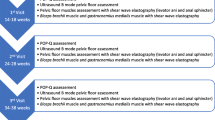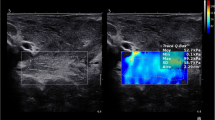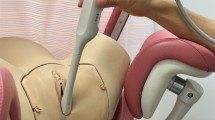Abstract
Objective
We aimed to investigate changes in the elastic properties of levator ani muscle (LAM) and external anal sphincter (EAS) during pregnancy using shear wave elastography (SWE). Our secondary objective was to examine the association between the elastic properties of pelvic floor muscles (PFM) and perineal tears at childbirth.
Methods
This was a prospective monocentric study, including nulliparous women. Three visits were planned (14–18, 24–28, and 34–38 weeks) with a SWE assessment of the LAM and EAS at rest and during Valsalva maneuver. Then, we collected data about the delivery’s characteristics. Assessments were performed using an Aixplorer V12® device (SL 18–5 linear probe) using a transperineal approach, reporting the shear modulus in kPa. We looked for changes in PFM’s elastic properties during pregnancy using one-way ANOVA for repeated measures. We compared the mean shear modulus in late pregnancy for each muscle and condition between women with an intact perineum at delivery and those with a perineal tear using Student’s t test.
Results
Forty-seven women were considered. Forty-five women had vaginal delivery of which 38 (84.4%) had perineal tears. We did not report any significant changes in the elastic properties of PFM during pregnancy. Women with an intact perineum at delivery had a stiffer EAS at Valsalva maneuver in late pregnancy (27.0 kPa vs. 18.2 kPa; p < 0.005).
Conclusions
There were no significant changes in the elastic properties of the PFM in pregnancy. Stiffer EAS in late pregnancy appears to be associated with a lower incidence of perineal tears.



Similar content being viewed by others
Data availability
Data are available from the first author on reasonable request.
References
Gachon B, Nordez A, Pierre F, Fritel X (2019) Tissue biomechanical behavior should be considered in the risk assessment of perineal trauma at childbirth. Arch Gynecol Obstet 300:1821–1826
Rusavy Z, Paymova L, Kozerovsky M, Veverkova A, Kalis V, Kamel RA et al (2022) Levator ani avulsion: a systematic evidence review (LASER). BJOG 129:517–528
van Delft K, Sultan AH, Thakar R, Schwertner-Tiepelmann N, Kluivers K (2014) The relationship between postpartum levator ani muscle avulsion and signs and symptoms of pelvic floor dysfunction. BJOG 121:1164–1171
Ducarme G, Pizzoferrato AC, de Tayrac R, Schantz C, Thubert T, Le Ray C et al (2019) Perineal prevention and protection in obstetrics: CNGOF clinical practice guidelines. J Gynecol Obstet Hum Reprod 48:455–460
Royal college of Obstetricians and Gynaecologists (2015) Green-top Guideline No. 29. The management of third- and fourth-degree perineal tears. https://www.rcog.org.uk/guidance/browse-all-guidance/green-top-guidelines/third-and-fourth-degree-perineal-tears-management-green-top-guideline-no-29/ (last consultation on the 01/01/2023)
Desseauve D, Proust S, Carlier-Guerin C, Rutten C, Pierre F, Fritel X (2016) Evaluation of long-term pelvic floor symptoms after an obstetric anal sphincter injury (OASI) at least one year after delivery: a retrospective cohort study of 159 cases. Gynecol Obstet Fertil 44:385–390
Fritel X, Gachon B, Saurel-Cubizolles MJ (2020) Postpartum psychological distress associated with anal incontinence in the EDEN mother-child cohort. BJOG 127:619–627
Pergialiotis V, Vlachos D, Protopapas A, Pappa K, Vlachos G (2014) Risk factors for severe perineal lacerations during childbirth. Int J Gynaecol Obstet 125:6–14
Meister MR, Cahill AG, Conner SN, Woolfolk CL, Lowder JL (2016) Predicting obstetric anal sphincter injuries in a modern obstetric population. Am J Obstet Gynecol 215(310):e311-317
Meyer R, Schwartz A, Horesh N, Alcalay M, Ram E, Levin G (2022) A dynamic prediction score for obstetric anal sphincter injury among nulliparous women delivering vaginally. Int J Gynaecol Obstet 157:271–276
Gachon B, Desgranges M, Fradet L, Decatoire A, Poireault F, Pierre F et al (2018) Is increased peripheral ligamentous laxity in term pregnant women associated with obstetric anal sphincter injury? Int Urogynecol J 29:1589–1595
Alperin M, Kaddis T, Pichika R, Esparza MC, Lieber RL (2016) Pregnancy-induced adaptations in intramuscular extracellular matrix of rat pelvic floor muscles. Am J Obstet Gynecol 215(210):e1-7
Alperin M, Lawley DM, Esparza MC, Lieber RL (2015) Pregnancy-induced adaptations in the intrinsic structure of rat pelvic floor muscles. Am J Obstet Gynecol 213(191):e1-7
Hug F, Tucker K, Gennisson JL, Tanter M, Nordez A (2015) Elastography for muscle biomechanics: toward the estimation of individual muscle force. Exerc Sport Sci Rev 43:125–133
Gachon B, Fritel X, Pierre F, Nordez A (2021) Transperienal ultrasound shear-wave elastography is a reliable tool for assessment of the elastic properties of the levator ani muscle in women. Sci Rep 11:15532
Gachon B, Nordez A, Pierre F, Fradet L, Fritel X, Desseauve D (2019) In vivo assessment of the levator ani muscles using shear wave elastography: a feasibility study in women. Int Urogynecol J 30:1179–1186
Gachon B, Clergue O, Fritel X, Pierre F, Nordez A (2023) In vivo assessment of the elastic properties of the external anal sphincter in term pregnant women using shear wave elastography. Int Uriogynecol J. https://doi.org/10.1007/s00192-023-05456-x
Gachon B, Fritel X, Pierre F, Nordez A (2020) In vivo assessment of the elastic properties of women’s pelvic floor during pregnancy using shear wave elastography: design and protocol of the ELASTOPELV study. BMC Musculoskelet Disord 21:305
Gachon B, Fritel X, Fradet L, Decatoire A, Lacouture P, Panjo H et al (2017) Is levator hiatus distension associated with peripheral ligamentous laxity during pregnancy? Int Urogynecol J 28:1223–1231
Schauberger SCW, Rooney BL, Goldsmith L, Shenton D, Silva PD, Schaper A (1996) Peripheral joint laxity increases in pregnancy but does not correlate with serum relaxin levels. Am J Obstet Gynecol 174:667–671
Marnach ML, Ramin KD, Ramsey PS, Song SW, Stensland JJ, An KN (2003) Characterization of the relationship between joint laxity and maternal hormones in pregnancy. Obstet Gynecol 101:331–335
Bump RC, Mattiasson A, Bo K, Brubaker LP, DeLancey JO, Klarskov P et al (1996) The standardization of terminology of female pelvic organ prolapse and pelvic floor dysfunction. Am J Obstet Gynecol 175:10–17
Dietz HP, Shek C, Clarke B (2005) Biometry of the pubovisceral muscle and levator hiatus by three-dimensional pelvic floor ultrasound. Ultrasound Obstet Gynecol 25:580–585
Orno AK, Dietz HP (2007) Levator co-activation is a significant confounder of pelvic organ descent on Valsalva maneuver. Ultrasound Obstet Gynecol 30:346–350
Eby SF, Song P, Chen S, Chen Q, Greenleaf JF, An KN (2013) Validation of shear wave elastography in skeletal muscle. J Biomech 46:2381–2387
Royer D, Gennisson JL, Deffieux T, Tanter M (2011) On the elasticity of transverse isotropic soft tissues. J Acoust Soc Am 129:2757–2760
Dietz HP, Shek KL (2009) Levator defects can be detected by 2D translabial ultrasound. Int Urogynecol J Pelvic Floor Dysfunct 20:807–811
Dietz HP (2018) Exoanal imaging of the anal sphincters. J Ultrasound Med 37:263–280
Catanzarite T, Bremner S, Barlow CL, Bou-Malham L, O’Connor S, Alperin M (2018) Pelvic muscles’ mechanical response to strains in the absence and presence of pregnancy-induced adaptations in a rat model. Am J Obstet Gynecol 218:512.e1-512.e9
Jelovsek JE, Chagin K, Gyhagen M, Hagen S, Wilson D, Kattan MW et al (2018) Predicting risk of pelvic floor disorders 12 and 20 years after delivery. Am J Obstet Gynecol 218:222e1-222.e19
Bolton H (2015) The Montgomery ruling extends patient autonomy. BJOG 122:1273
Egorov V, van Raalte H, Sarvazyan AP (2010) Vaginal tactile imaging. IEEE Trans Biomed Eng 57:1736–1744
Kruger JA, Nielsen PM, Budgett SC, Taberner AJ (2015) An automated hand-held elastometer for quantifying the passive stiffness of the levator ani muscle in women. Neurourol Urodyn 34:133–138
Chen L, Low LK, DeLancey JO, Ashton-Miller JA (2015) In vivo estimation of perineal body properties using ultrasound quasistatic elastography in nulliparous women. J Biomech 48:1575–1579
Funding
There was no funding for this study.
Author information
Authors and Affiliations
Contributions
Each author of this work meets the criteria for authorship: BG contributed to the study design, performed shear wave elastography assessments, performed the analysis, and wrote each version of the main text of this manuscript; XF and FP contributed to statistical analysis, and review each version of the manuscript; AN contributed to the study design and data analysis, draft the work, and review each version of the manuscript.
Corresponding author
Ethics declarations
Conflict of interest
All the authors certify that they have no affiliations with or involvement in any organization or entity with any financial interest or non-financial interest in the subject matter or materials discussed in this manuscript.
Additional information
Publisher's Note
Springer Nature remains neutral with regard to jurisdictional claims in published maps and institutional affiliations.
Rights and permissions
Springer Nature or its licensor (e.g. a society or other partner) holds exclusive rights to this article under a publishing agreement with the author(s) or other rightsholder(s); author self-archiving of the accepted manuscript version of this article is solely governed by the terms of such publishing agreement and applicable law.
About this article
Cite this article
Gachon, B., Fritel, X., Pierre, F. et al. In vivo measurement of the elastic properties of pelvic floor muscles in pregnancy using shear wave elastography. Arch Gynecol Obstet 309, 2623–2631 (2024). https://doi.org/10.1007/s00404-023-07174-7
Received:
Accepted:
Published:
Issue Date:
DOI: https://doi.org/10.1007/s00404-023-07174-7




